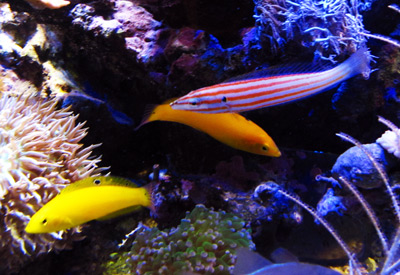The other night, as I was watching the debate on TV, I noticed that my reef tank got darker. Just a little, but it was darker and yellower. I opened the front (it is in a wall) and noticed that half the LEDs were out. “Okay, no problem,” I thought. “I’ll fix it in the morning.” The lights were about to go out anyway.
As I watched, I noticed that my pair of fire clowns, which have a love-hate relationship, looked like they wanted to spawn. The larger one was trying to entice the smaller one into a bottle “cave.” The smaller one eventually followed, and the pair spent “time in the bottle” (reminds me of a song), swimming very close to each other, although I couldn’t hear what they were saying.
As I was watching the clowns, I couldn’t help noticing that my pair of bright yellow wrasses was also attempting to spawn. The larger one, who I assume is a male, dug an impression about 2 inches deep and 4 inches wide in the gravel and kept following the female and guiding her to this nest. As he chased her around, he also did this little Macarena dance, which I assume she liked because she kept following him to the nest while she batted her eyelashes.
Unfortunately, the female is not pregnant enough to spawn right now. Nor is the fire clown, even though the two clowns were intertwining and dancing like they were trying to spawn (which they do all the time). I personally have never seen wrasses spawn and would like them to get on with it. Interestingly, my two bluestripe pipefish were also spending some very close time together, although the male is already very pregnant, as he often is.
Why am I telling you this (and why are you reading it)? All this behavior was, in part, due to the change in lighting.
Lighting is something we typically discuss only in relation to corals. We discuss lumens, PAR, color, height above the tank, LED, MH, VHO, PC, etc. But we never discuss how the lighting on a reef ebbs and grows through the day and night. Yes, night.
If you’ve ever gone scuba diving at night, you know the nighttime reef is a totally different place. I am basically a lobster diver, so I’ve done quite a few night dives here in New York. Totally different creatures emerge at night while the daytime creatures normally hide. This happens in our tanks also, but the big difference is that on a reef, the sun doesn’t automatically shut off at precisely 10:00 p.m., leaving the tank in total darkness. The natural reef does go completely dark, but not instantly. Gradually, as the day wanes, the reef darkens. Some days it goes completely dark, while other times the moon is so bright that it almost seems like daytime.
Fish have no problem navigating at night due to their lateral lines, but they do have a problem if they find themselves plunged instantly into total darkness. This is extremely abnormal and fish don’t like it. I don’t like it either. If my electricity goes out at night leaving me in a completely dark room, I struggle to find my way around, looking for a flashlight.
Fish and corals run their schedules according to the moon even more than the sun. Corals especially are in tune with the moon. They also know that these changes happen gradually. The sun over the tropical seas rises and sets about the same time every day of the year. But the moon does not. The moon illuminates the sea with varying degrees of brightness as it waxes and wanes.
As far as I know, no one duplicates this in a home tank, but I think it may be much more important than we have been thinking, or not thinking. Of course, most of us can’t read the minds of our fish, but I feel that lighting, or the lack of it, is a very important topic that they would like us to discuss. And why wouldn’t they? After all, light controls a major part of their life, as fish run on instinct, unlike many of us who run on junk food.



